The Simple Present Tense , also called Present Simple (simple present), is one of the tenses of English.
It is equivalent to the present indicative in the Portuguese language.
When to use Simple Present?
The Simple Present is a verb tense used to indicate habitual actions that occur in the present.
In addition, it is used to express universal truths , feelings , desires , opinions and preferences .
Sometimes phrases in Simple Present have expressions of time (adverbs).
The most usual are:
| Adverb | Translation |
|---|---|
| now | now |
| always | ever |
| never | Never |
| today | today |
| every day | every day |
| daily | daily |
| often | often |
| sometimes | sometimes |
| generally | usually |
| usually | usually |
See some example sentences in Simple Present :
- He plays soccer very well . (He plays football very well.)
- She loves chocolate . (She loves chocolate.)
- They go to school in the afternoon. (They go to school in the afternoon.)
- I always read the newspaper in the morning . (I always read the newspaper in the morning.)
- We generally travel to Brazil in December . (We usually travel to Brazil in December.)
Simple Present rules
The conjugation of Simple Present varies according to the verbal person, the verb ending and the type of sentence (affirmative, negative and interrogative.)
Check below the explanation about the formation of the S imple Present in the affirmative , negative and interrogative forms .
Affirmative Form
As a general rule, it can be said that to conjugate a verb in the S imple Present , just use it in the infinitive without the to in the case of the pronouns I , you , we and they , and add – s , – es or – ies in case of the pronouns he , she and it .
Below is an example with the conjugation of the verb to work :
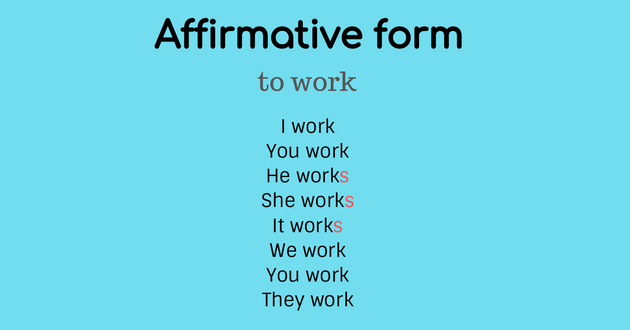
However, there are some specific rules for the inflection of the third person singular ( he, she and it ) that are related to the ending of verbs.
Verbs ending in -o, -z, -ss, -ch, -sh, -x
We should add – es at the end of the verb.
Examples :
- to teach – teaches
- to watch – watches
- to push – pushes
- to kiss (kisses) – kisses
- to go (go) – goes
- to fix – fixes
Verbs ending in – y preceded by consonant
Remove the – y and add – ies
Examples :
- to fry – fries
- to fly – flies
- to study – studies
- to worry – worries
Verbs ending in – y preceded by a vowel
Only the – s are added.
Examples :
- to say – says
- to play – plays
Verb position in affirmative sentences
See below the structure of forming affirmative sentences in Simple Present:
Subject + main verb + complement
Examples :
- I live in Brazil . (I live in Brazil). – verb to live (live, live).
- He teaches Spanish at the university . (He teaches Spanish at the university.) – verb to tea ch (to teach).
- They prefer Italian food. (They prefer Italian food.) – verb to prefer (prefer).
- She watches TV every day . (She watches TV every day.) – verb to wat ch (to watch).
- We like to go to the beach during the week . (We like to go to the beach during the week.) – verb to like .
- It pushes the door when it wants to get in. (He / she pushes the door when he wants to enter) – verb to pu sh (to push).
- You always arrive late . (You always arrive late.) – verb to arrive .
- She always kisses her grandma before leaving . (She always kisses her grandmother before leaving.) – verb to ki ss (to kiss).
- He goes to the gym on weekends. (He goes to the gym on weekends.) – verb to g o (go).
- She fixes her car by herself. (She repairs her car by herself. ) – verb to fi x (fix).
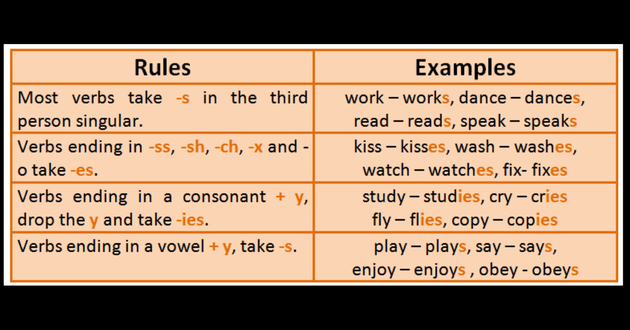
Negative Form
The negative form of Simple Present is formed using the auxiliary verbs of and does .
Do is used with the pronouns I , you , we and they. The does helper is used with he , she , it .
See below the conjugation of the negative form of the verb to work in Simple Present.

Note that in the negative form of Simple Present , the verb is always used in the infinitive without the to , even when it comes to the third person singular ( he , she and it ).
Negative phrases can be written completely ( do not or does not ) or contracted ( don’t or doesn’t ):
- Do + not = don’t
- Does + not = doesn’t
Verb position in negative sentences
See below the structure of forming negative phrases in Simple Present :
Subject + auxiliary verb + not + main verb + complement
Examples :
- I do not live in Brazil . (I don’t live in Brazil). – verb to live (live, live).
- He does not teach Spanish at the university . (He does not teach Spanish at the university.) – verb to teach .
- They don’t prefer Italian food. (They do not prefer Italian food.) – verb to prefer (prefer).
- She doesn’t watch TV every day . (She doesn’t watch TV every day.) – verb to watch .
- We do not like to go to the beach during the week . (We don’t like to go to the beach during the week.) – verb to like .
- It does not push the door when it wants to get in. (He / she does not push the door when he wants to enter.) – verb to push .
- You don’t arrive late . (You are not late.) – verb to arrive .
- She doesn’t kiss her grandma before leaving . (She doesn’t kiss her grandmother before she leaves.) – verb to kiss .
- He does not go to the gym on weekends. (He does not go to the gym on weekends.) – verb to go .
- She doesn’t fix her car by herself. (She doesn’t fix her car on her own. ) – verb to fix (fix).
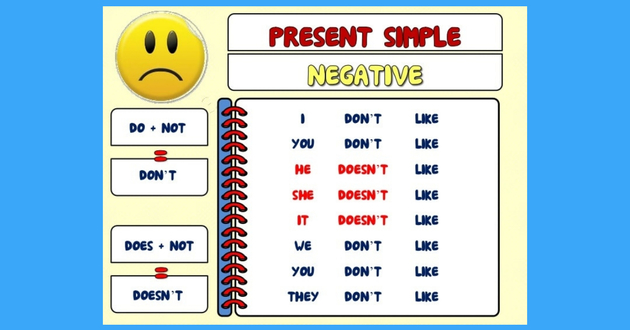
Interrogative Form
Just as in negative sentences, the auxiliary ‘s and does are used to form interrogative sentences in Simple Present .
Do is used with I , you , we and they , and does is used with he , she and it .
See below the conjugation of the interrogative form of the verb to work in Simple Present :
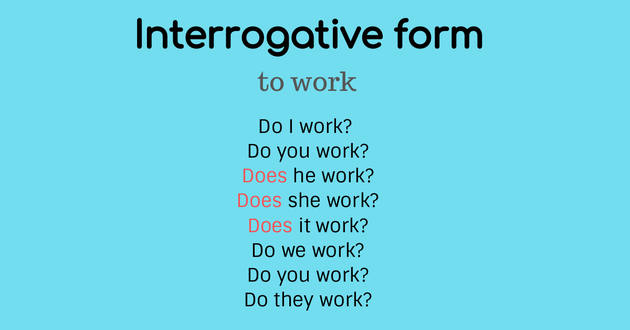
Note that the verb is always used in the infinitive without the to , even when it comes to the third person singular ( he , she and it ).
Verb position in interrogative sentences
See below the structure for forming interrogative phrases in Simple Present .
Auxiliary verb + subject + main verb + complement
Examples:
- Do I own you money? (Do I owe you money?). – verb to own (duty).
- Does he teach Spanish at the university? (Does he teach Spanish at the university?) – verb to teach .
- Do they prefer Italian food? (Do they prefer Italian food?) – verb to prefer (prefer).
- Does she watch TV every day? (Does she watch TV every day?) – verb to watch .
- Do we have classes on Saturdays? (Do we have classes on Saturdays?) – verb to have (to have).
- Does it push the door when it wants to get in? (Does he / she push the door when you want to enter?) – verb to push .
- Do you arrive late? (Are you late?) – verb to arrive .
- Does she kiss her grandma before leaving? (Does she kiss her grandmother before she leaves?) – verb to kiss .
- Does he go to the gym on weekends? (Does he go to the gym on weekends?) – verbto go(to go).
- Does she fix her car by herself? (Does she fix her car on her own? ) – verb to fix .
IMPORTANT
The verb to do means to do . However, in Simple Present it is used as an auxiliary verb that complements the formation of negative and interrogative phrases.
As auxiliaries, do and does have no meaning.
And does helpers are also used in short answers.
Look at the examples below:
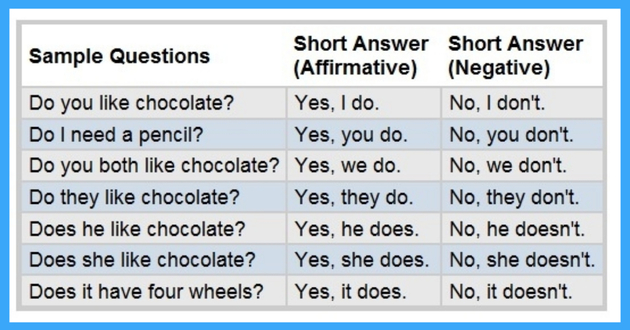
Conjugated verbs tables
Now that you have learned the rules of Simple Present , see some examples of conjugated verbs.
Verb to love
| Affirmative | Negative | Interrogative |
|---|---|---|
| I love | I do not / don’t love | Do I love? |
| You love | You do not / don’t love | Do you love? |
| He loves | He does not / doesn’t love | Does he love? |
| She loves | She does not / doesn’t love | Does she love? |
| It loves | It does not / doesn’t love | Does it love? |
| We love | We do not / don’t love | Do we love? |
| You love | You do not / don’t love | Do you love? |
| They love | They do not / don’t love | Do they love? |
Verb to be
| Affirmative | Negative | Interrogative |
|---|---|---|
| I am / I’m | I am not / I’m not | Am I? |
| You are / You’re | You are not / aren’t | Are you? |
| He is / He’s | He is not / isn’t | Is he? |
| She is / She’s | She is not / isn’t | Is she? |
| It is / It’s | It is not / isn’t | Is it? |
| We are / We’re | We are not / aren’t | Are we? |
| You are / You’re | You are not / aren’t | Are you? |
| They are / They’re | They are not / aren’t | Are they? |
Obs .: As with the verbs modal (modal verbs), the negative and interrogative form of the verb be to are not formed with the use of auxiliary of and does .
Verb to have
| Affirmative | Negative | Interrogative |
|---|---|---|
| I have | I do not / don’t have | Do I have? |
| You have | You do not / don’t have | Do you have? |
| He has | He does not / doesn’t have | Does he have? |
| She has | She does not / doesn’t have | Does she have? |
| It has | It does not / doesn’t have | Does it have? |
| We have | We do not / don’t have | Do we have? |
| You have | You do not / don’t have | Do you have? |
| They have | They do not / don’t have | Do they have? |
Simple Present x Present Continuous
Both Simple Present and Present Continuous are verb tenses in the English language that indicate present tense.
However, it is common for both to cause doubts to those who want to practice and build sentences in English.
The Simple Present indicates habitual actions that took place in the present and also universal truths , feelings , desires , opinions and preferences .
The Present Continuous, on the other hand, indicates actions that are taking place in the present, that is, at the moment when we speak. It is equivalent to the gerund of the Portuguese language. As a general rule, to conjugate the Present Continuous , it is necessary to add – ing at the end of the verb.
Examples :
- They are watch ing a movie . (They are watching a movie.) – verb to watch .
- I am mak ing the phone call . (I’m making a phone call.) – verb to make .
See below some phrases in Simple Present and Present Continuous that illustrate the difference between the two tenses.
Examples :
- He is play ing baseball . (He’s playing baseball.) – PRESENT CONTINUOUS
- He plays baseball. (He plays baseball.) – SIMPLE PRESENT
- They study German . (They study German.) – SIMPLE PRESENT
- They are study ing German . (They are studying German.) – PRESENT CONTINUOUS
Simple Present Exercises
Question 1
In the age-old battle between independence-seeking teenagers and worried parents, the older generation is packing some new weapons. Caller ID tells parents who is calling their kids. Cell-phone bills detail every local number the kid has called. New computer programs track just about everything – every website visited, every email sent – that a teenager does online.
Parental reconnaissance is going to get worse – or good, depending on your perspective.
The verbs that are in the Simple Present, in the text, are:
a) detail – track – get
b) worried – visited – sent
c) is packing – is calling – is going
d) tells – detail – track
e) worried – has called – does
Answer
Correct alternative: d) tells – detail – track
Alternative d) is the only one where all verbs are inflected in Simple Present .
- Tells is bending present simple verb to tell (mean) , the third person singular ( he / she / it ).
- detail is the Simple Present inflection of the verb to detail , used with the pronouns I , you , we , they .
- track is the Simple Present inflection of the verb to track , used with the pronouns I , you , we , they .
See what are the tenses of the other alternatives:
a) detail – track – get : detail and track are in Simple Present , however, in the text, the verb get is part of the future structure of Simple Future , going to get .
b) worried – visited – sent : all verbs are in Simple Past .
c) is packing – is calling – is going : is packing and is calling are in the Present Continuous. The is going is part of the future structure of the Simple Future , is going to get .
e) worried – has called – does : worried is in Simple Past , has called is in Present Perfect and does is the only verb in Simple Present .
Question 2
(Ufac / 2010) Choose the alternative that best completes the sentence:
Charles normally ________ water, but now he ________ Coke.
a) drinks; is drinking.
b) is drinking; drinks.
c) was drinking; drinks.
d) drink; is drinking.
e) drinks, was drinking.
Answer
Correct alternative: a) drinks; is drinking.
Note that the adverb normally (normally), which indicates a habitual action, was used in the sentence . Therefore, the verb to be used to complete the gap must be conjugated in Simple Present .
Of the available alternatives, only the letters a), d) and e) are adequate. The letter b) starts with a conjugated flexion in the Present Continuous (is drinking) and the letter c) has its first conjugated option in the Past Continuous ( was drinking ).
In the second part of the sentence, the word now was used , which requires the use of a conjugated verb in the Present Continuous to indicate an action in progress in the present.
Options a) and d) remain. The correct option was the letter a) because the subject of the sentence is Charles, which corresponds to the pronoun he (he). For he , she and it should add the – s the end of the verb.
Question 3
Tick the correct alternative to complete with Simple Present :
She doesn’t ________ anymore.
a) to work out
b) work out
c) working out
d) works out
e) worked out
Answer
Alternative b: She doesn’t work out anymore.
The sentence presents a third-person inflection of the singular ( he , she and it ) in the negative form of Simple Present , indicated by the use of doesn’t .
When does or does not are used, the main verb must be used in the infinitive without the to .
The infinitive in question is to work out , so you start to work out without to . Therefore, the letter b) is the correct alternative.
Question 4
Fill in the spaces with the conjugation of the verbs in Simple Present :
a) Do you ______ in America? (to live)
Answer
Correct answer: a) live
Since the sentence is a question, the verb must be used in the infinitive without the to . In this case, as the infinitive is to live , just use live.
b) Jane ______ your friend. (to love)
Answer
Correct answer: b) loves
Jane is the subject of the sentence. As it is a feminine name, it is equivalent to the pronoun she .
The bending Simple Present of he , she , and it must be done with -s addition to the end of the infinitive without to .
The infinitive is to love . Without the to , we have only love . So just add the – s : loves
c) Juan and Carla ______ on the beach every morning. (to run)View Answer
Correct answer: c) run
Juan and Carla are equivalent to the pronoun they .
To inflect the verb to run (run) in the third person plural ( they ), just use the verb in the infinitive without the to . Since the infinitive is to run , without to we have only run . Soon, Juan and Carla run .
d) She _______ English every day. (to teach)
Answer
Correct answer: d) teaches
When a verb ends in – the – z – s s, – CH , – SH or – x , the bending Simple Present of he , she , and it must be done with the addition of – s after the infinitive without to .
The infinitive is to teach . Without the to , we now have only teach . Therefore, just add the -e s : teaches.
e) Thomas ______ his car weekly. (to wash)
Answer
Correct answer: washes
When a verb ends in – the – z – s s, – CH , – SH or – x , the bending Simple Present of he , she , and it must be done with the addition of – s after the infinitive without to .
The infinitive is to wash . Without the to , we now have only wash . So just add the -e s : washes.
Question 5
Write the following sentence in negative and interrogative forms:
We go to school every day.
Answer
Negative form:
Correct answer: We don’t go to school every day or We do not go to school every day.
The main verb of the sentence is to go .
To form negative phrases in Simple Present , you must use the helper do or helper does, and add not. You can also use the contracted forms don’t or doesn’t .
Does not and doesn’t are used with the pronouns he , she and it . With the other pronouns ( I , you, we and they ) do not or don’t.
After the helper, you must use the main verb in the infinitive without the to . As the main verb of the sentence in the infinitive is to go , without to we have go .
Verb position in negative sentences: subject + auxiliary verb + not + main verb + complement
Bearing in mind that the pronoun used in the sentence is we (we), we can choose to use do not or don’t:
- We don’t go to school every day.
- We do not go to school every day.
Interrogative form:
Correct answer: Do we go to school every day?
The main verb of the sentence is to go .
To form interrogative sentences in Simple Present , you should use the help of the or the auxiliary does.
Does is used with the pronouns he , she and it . With the other pronouns ( I , you, we and they ) we use do.
After the helper, you must use the main verb in the infinitive without the to . As the main verb of the sentence in the infinitive is to go , without to we have go .
Verb position in interrogative sentences: auxiliary verb + subject + main verb + complement
Bearing in mind that the pronoun used in the phrase is we , the correct answer is Do we go to school every day?
Question 6
According to the formation of the phrases in Simple Present , the sentence in which the words appear in the correct order is:
a) My girlfriend visits her parents on Sundays.
b) On Sundays my girlfriend her parents visits.
c) Visits her parents on Sundays my girlfriend.
d) My girlfriend parents her visits on Sundays.
e) Her parents my girlfriend visits on Sundays.
Answer
Correct alternative: a) My girlfriend visits her parents on Sundays.
In Simple Present , the formation of affirmative sentences follows the following structure:
Subject + main verb + complement
- Subject: My girlfriend
- Main verb: visits
- Complement: her parents on Sundays
Question 7
Complete with the correct form of the verb in parentheses.
a) They ______ their email every day. (check-checks)
b) The sun ______ in the east. (rise-rises)
c) We ______ shopping on Saturdays. (go-goes)
d) Water ______ at 100 ° C. (boil-boils)
e) Daniel ______ for a big hotel in the city center. (work-works)
Answer
To conjugate a verb in Simple Present , just use it in the infinitive without the to in the case of the pronouns I , you , we and they , and add – s , – es or – ies in the case of the pronouns he , she and it . So, the correct answers are:
a) check – They check their email every day. (They check their e-mails every day.)
B) rises – The sun rises in the east. (The sun rises in the east.)
C) go – We go shopping on Saturdays. (We go shopping on Saturdays.)
D) boils – Water boils at 100 ° C. (Water boils at 100 ° C.)
E) works – Daniel works for a big hotel in the city center. (Daniel works for a large hotel in the city center.)
Question 8
Complete the gaps with the correct auxiliary verb: to do or to be .
a) ______ you married?
Yes, my husband’s name is Frank.
b) ______ do you have any children?
Yes, I have three sounds.
c) Where ______ do you work?
I’m a doctor at the local hospital.
d) What ______ their names?
Lucy and Tomas.
e) What ______ you do?
I work in a club.
Answer
Both the verb to do and the verb to be can be used in English as auxiliary verbs.
The verb to do, as an auxiliary, has no translation.
The verb to be is used when the meaning of the phrase is related to the verbs “to be” or “to be”. Thus, the answers to the questions are:
a) are – Are you married? (Are you married?)
B) do – Do you have any children? (Do you have children?)
C) do – Where do you work? (Where do you work?)
D) are – What are theirs names? (What are their names?)
E) do – What do you do? (What do you do?)
Question 9
In the sentences below, insert frequency adverbs in parentheses in the correct location.
a) Do you work late? (often)
b) I’m exhausted. (always)
c) I finish at four in the morning. (usually)
d) I work till six. (once a week)
Answer
Frequency adverbs are used between the subject and the verb, except when the main verb of the sentence is to be . Check the correct answers:
a) Do you often work late? (Do you usually work late?)
B) I’m always exhausted. (I’m always exhausted.)
C) I usually finish at four in the morning. (I usually finish at four in the morning.)
D) I work till six once a week. (I work until six once a week.)
Question 10
Read the phrases below about grammatical rules about using Simple Present .
I. By combining the Simple Present a verb ending in y preceded by a consonant, just add the – s in the grammatical inflections people he , she and it.
II. The Simple Present is used to talk about habits and routines, and universal truths.
III. In the interrogative form of Simple Present , the main verb is not inflected. It is used in the infinitive without the to .
What is stated in:
a) I and III
b) I and II
c) II and III
d) I, II and III
e) nda
Answer
Correct answer: c) II and III
The statement of sentence I is incorrect, since when conjugating in Simple Present a verb ending in y preceded by a consonant, it is necessary to add – ies , and not just -s , in the grammatical inflections of he , she and it.
